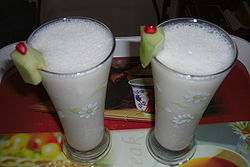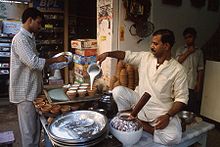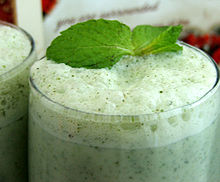- Lassi
-
For other uses, see Lassi (disambiguation).
Lassi 
Fat-free lassi from Mumbai, IndiaOrigin Place of origin Indian Subcontinent Dish details Main ingredient(s) yogurt, cream Lassi (Punjabi: ਲੱਸੀ, Hindi: लस्सी, Gujarati: છાસ, Bangla: লাচ্ছি, Urdu: لسی) is a popular and traditional yogurt-based drink of the Indian Subcontinent. It is made by blending yogurt with water and Indian spices.[1] Traditional lassi (also known as salted lassi, or, simply lassi) is a savory drink sometimes flavored with ground roasted cumin while sweet lassi on the other hand is blended with sugar or fruits instead of spices.
In Dharmic religions, yogurt sweetened with honey is used while performing religious rituals. Less common is lassi served with milk and is topped with a thin layer of clotted cream. Lassis are enjoyed chilled as a hot-weather refreshment, mostly taken with lunch. With a little turmeric powder mixed in, it is also used as a folk remedy for gastroenteritis.
Contents
Variations
Traditional mild salted lassi
 A Lassi shop in Varanasi
A Lassi shop in Varanasi
.
This form of lassi is more common in the villages of Punjab. It is prepared by blending yogurt with water and adding salt and other spices to taste. The resulting beverage is known as salted lassi. This is similar to Ayran or Doogh.
Sweet lassi
Sweet lassi is a form of lassi flavored with sugar, rosewater and/or lemon, strawberry or other fruit juices. Saffron lassis, which are particularly rich, are a specialty of Sindh in Pakistan and Jodhpur and Rajasthan in India. Makkhaniya lassi is simply lassi with lumps of butter in it (makkhan is the Punjabi, Urdu, Hindi and Gujarati word for butter). It is usually creamy like a milkshake.
Mango lassi
Mango lassi is most commonly found in India and Pakistan though it is gaining popularity worldwide. It is made from yogurt, water and mango pulp. It may be made with or without additional sugar. It is widely available in UK, Malaysia and Singapore, due to the sizable Indian/Pakistani minority, and in many other parts of the world. In various parts of Canada, mango lassi is a cold drink consisting of sweetened kesar mango pulp mixed with yogurt, cream, or ice cream. It is served in a tall glass with a straw, often with ground pistachio nuts sprinkled on top.[2]
Bhang lassi
Bhang (or bhung) lassi is a special lassi that contains bhang, a liquid derivative of cannabis (marijuana), which has effects similar to other eaten forms of cannabis. It is legal in many parts of India and mainly sold during Holi, when pakoras containing bhang are also sometimes eaten. Rajasthan is known to have licensed bhang shops, and in many places one can buy bhang products and drink bhang lassis.[3] However, the term "bhang lassi" is more often a misnomer, as it is almost always made with thandai, a drink made with either milk or water, crushed ice, sugar, and other ingredients such as kesar pista, thandai syrup, saffron, ground almonds, spices, ground melon and poppy seeds.
Chaas
Chaas or chaach is a salted drink like lassi; however, chaas contains more water than lassi and has the butterfat removed, so its consistency is not as thick as lassi. Salt and Jeera (cumin seeds) are normally added for taste and sometimes even fresh coriander. Fresh ground ginger & green chillies may also be added as seasoning. Chaas is popular in the Indian states Gujarat and Rajasthan, where it is drunk with the main meal.[citation needed] It is known to aid digestion[citation needed] and is an excellent coolant in the Indian and Pakistani summers[citation needed]. It is called 'majjige' in Kannada, 'taak' in Marathi, 'majjiga' in Telugu and 'moru' in Tamil and Malayalam.
Ayran
In Turkey and other East-Mediterranean countries such as Lebanon and Syria, there is a similar drink to Lassi called Ayran. It is made out of yogurt and water.
Doogh
In Iran and Afghanistan a similar drink is called Doogh.
Tahn
Tahn is the Armenian version of the yogurt drink, consumed cold, with or without food. It is diluted with water and is flavored with salt.
Cultural references
A 2008 print[4] and television[5] ad campaign for HSBC, written by Jeffree Benet of JWT Hong Kong, tells a tale of a Polish washing machine manufacturer's representative sent to India to discover why their sales are so high there. On arriving, the representative investigates a Lassi parlour, where he is warmly welcomed, and finds several washing machines being used to mix Lassi. The owner tells him he is able to "make ten times as much Lassi as I used to!"
On his No Reservations television program, celebrity chef Anthony Bourdain visited a "Govt Authorised" Bhang Shop in Jaisalmer Fort, Rajasthan. The proprietor offered him three varieties of bhang lassi: "normally strong, super duper sexy strong, and full power 24 hour, no toilet, no shower."
See also
References
- ^ "The Hindustan Times article". Hindustan Times. http://www.hindu.com/2005/07/20/stories/2005072007131800.htm. Retrieved 2005-07-16.
- ^ http://www.bbc.co.uk/food/recipes/database/mangolassi_67363.shtml
- ^ Anthony Bourdain: No Reservations Collection 2, Episode 5; Final Segment
- ^ "Can This Lassi Ad Really Be True?". indiablogs.searchindia.com. 2008-10-04. http://64.233.183.104/search?q=cache:cEpz3roXqJoJ:indiablogs.searchindia.com/2008/10/04/can-this-really-be-true/+hsbc+lassi+%22new+yorker%22&hl=en&ct=clnk&cd=1&gl=uk&client=firefox-a. Retrieved 2008-10-19.
- ^ "HSBC Bank : Washing Machine and Lassi". Adoholik. 2008-09-27. http://adoholik.com/2008/09/27/hsbc-bank-washing-machine-and-lassi/. Retrieved 2008-10-19.
External links
Categories:- Yoghurts
- Dairy products
- Fermented foods
- Non-alcoholic beverages
- Indian beverages
- Pakistani beverages
- Punjabi cuisine
- Punjabi words and phrases
Wikimedia Foundation. 2010.


